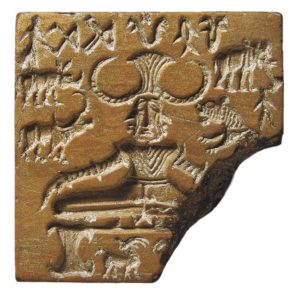5,000 years?

I have to admit, I sometimes ask myself if I’m part of this world. The yoga world, I mean. On Tuesday, the New York Times wrote a piece on foodies and yoga, and it seems to be popular, given its rank on their most emailed list: “When Chocolate and Chakras Collide.”
My favorite part of the piece was a comment from Sadie Nardini about judgment in the yoga world, about being “yogier than thou.” What do I think about sampling food on a yoga mat? To each her own. Is it yoga? Does it matter?

I′m not terribly troubled by what people choose to call yoga, as most of what is practiced now bears little resemblance to its history, and why should it? Traditions need to evolve to be relevant. I do have a pet peeve about the “5000-year-old practice” line (which appeared in that NYT article), stated as if yogis were hopping through sun salutations in 2990 b.c.e. They weren’t.
The philosophy of yoga is fairly old and can be dated back to at least the mid-first century b.c.e. Some of the asanas (postures) can be definitively dated back to the 10th century c.e., as described in the Pāñcarātrika Samhitās (see Mallinson), but many date back only a century or two. Years ago, in one of the first books I read on yoga (I don’t read that much about yoga, I practice it), Joseph Alter’s Yoga in Modern India, he asserts that the sun salutations are adapted from Indian martial tradition in the late 1800s, when the Hindu masculinity movement was strong, and ever since it’s grated on me when people boast that yoga is 5,000 years old. The date of 5,000 b.c.e. comes from an ancient seal found in Mohenjo-daro with Shiva sitting in a seated position (though Shiva was not quite Shiva until around 200 b.c.e). All around, the argument is pretty weak. A picture of someone sitting = yoga? There are images of Egyptians in backbends. Were they yogis? You can imagine the fun academics have pulling that apart. Many agree that not only is it not yoga, but not Shiva, or even necessarily male. It’s important to note as well that the seal was found in a series of seals with figures depicted in other less formal, less yogic-looking seats (see Doris Srinivasan, “The So-Called Proto-śiva Seal from Mohenjo-Daro: An Iconological Assessment,” Archives of Asian Art, Vol. 29, (1975/1976), pp. 47-58).
Looking around the web, I’m glad to see that others seek historical accuracy as well, e.g. Kate Churchill and Nick Rosen in the documentary Enligthen Up! The next post flushes out my less quantitative take on the matter.
…
Anastasia, while I agree with you on keeping the yoga elitism in check, I personally believe that kinds of consciousness one accesses by practicing yoga are as old as humanity itself. While of course yoga in its popular form today is nowhere near 5,000 years old, I regard anything that brings one closer to the full embodiment and expression of oneself to be “yoga.” Regardless of the dating of the sun salutation and the yoga sutras, the experience of harmony and wholeness is ageless.
Ben, I knew that was coming! I’ll answer in another post, because I’ve more to say. xoA
Hard to believe it has been around for that long and I just got started in it lol.
Were you there 5000 years ago to claim that yoga didn’t exist? This is the epitome of western snobbishness and stupidity. Learn to read more.
Hi Elle. Thanks for your comment. I do wonder, were you there 5000 years ago?
If you read a bit closer (quantity is not everything), you will notice that I said yogis weren’t hopping through sun salutations 5000 years ago. And that the seal is not proof of a physical yoga practice. That said, we have no idea how old “yoga” (by which I mean the postural practice) is–it isn’t a textual practice.
Perhaps you’d like to share what I should read, and we can discuss.